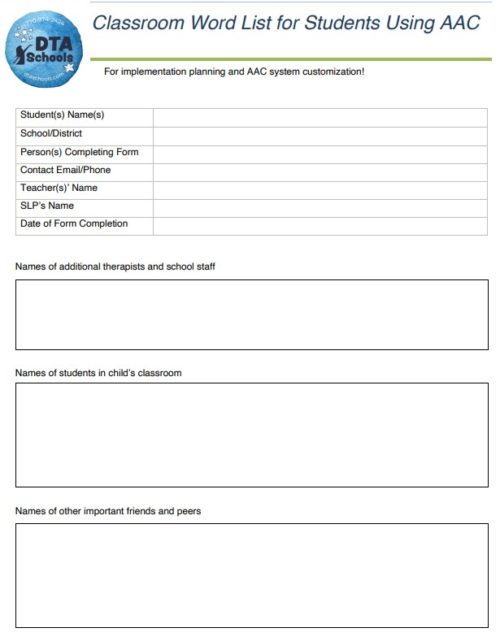AAC Implementation Framework: Step 1, Determining the Target
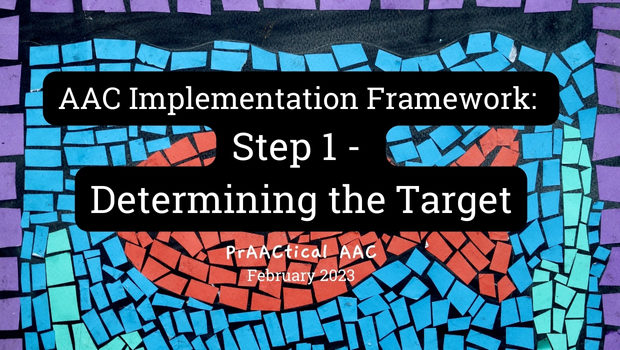

Today, we continue our series sharing an AAC Implementation Framework for classrooms, featuring guest author, Vicki Clarke. In her initial post, Vicki shared the contours of the framework. In this post, she digs into the specifics, with prAACtical strategies and downloadable forms that you may find helpful. Don’t miss the video at the end.
::::::::::::::::::::::::::::::::::::::::::
AAC 101 Steps of Learning: Step One- Target
In Step One, we will be determining which words and messages we need to specifically target for instruction. We often complete the step, not only for targeting specific words and messages, but also when we are first designing the AAC system that our students will be using. We will use three techniques to choose our target words and messages:
- Consider which words and messages are important to the individual student, their family, friends, and teacher. We will be asking all of these partners for their input as we choose the most motivating, significant words and messages to target.
- Observe the student interacting in their typical environment so we can determine what messages are necessary in order for the student to participate fully. Consider what words and messages will initiate and sustain social interactions and meet basic communicative needs. Choose words/ messages that are easy to understand, including everyday language and regular occurrences.
- Consider developmental norms and frequency of vocabulary, grammar, and pragmatic development for those students who are learning language at the same time they are learning to communicate.
The first strategy in choosing words and messages involves asking the stakeholders, or the student’s family, friends, and teaching team, to give us input on which words and messages are significant and motivating. We do this in two formats depending on the comfort level of the people we are surveying. The Classroom Word List and a Home Word List are documents we can send to the family, friends, and school team to complete. These documents ask for the names of family and friends, pets, favorite foods, places that the student regularly goes to, and favorite activities and interests. There are checklists, whenever possible, to make this a quick and easy task for the relevant stakeholders to complete.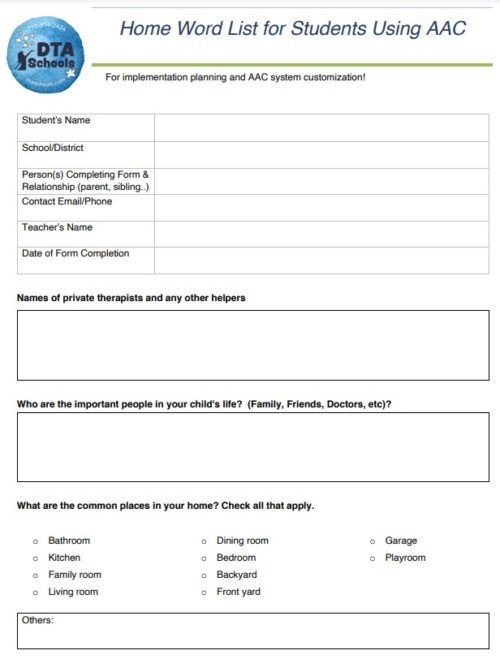
For our partners who are comfortable completing online surveys, we use a Google form document for the home words for communication and another for classroom words for communication. These links can be emailed directly to the stakeholders and completed online. The results of these surveys come directly to our team so that we can begin the process of customizing the new communication system. The team can also print out the results of the surveys to help them consider which words to target initially.
The second strategy that we use to target significant words and messages is observation. We observe the student in their typical activities as well as interview their partners to understand the activities and environments the student typically engages in during the day. We have two tools we use for this purpose, the Classroom Communication Environment Schedule Analysis and the Home and Community Communication Environment Schedule Analysis forms. The forms allow us to analyze the student’s schedule and consider the primary communicative objectives during those activities and the words and messages that are needed. There’s even a column for you to note the location or method of communication the student uses during this time of day.
The Communication Matrix, and the Communication Sampling and Analysis tools, are exceptional observational tools we use to assist us in choosing communication targets. Both of these tools allow us to observe our students, consider what they are already communicating through other modalities, and determine which messages might be more easily communicated and understood using the AAC system.
Classroom Communication Project (CCP) Schedule Analysis
This form is for teachers to complete a detailed schedule of their AAC user(s) day. Information includes the activity, partners, and the messages teachers feel their student(s) need(s). There is an additional worksheet for teachers to give us information regarding student and teacher names, favorite foods, places, activities, etc. You can also use this form instead of the above-mentioned surveys.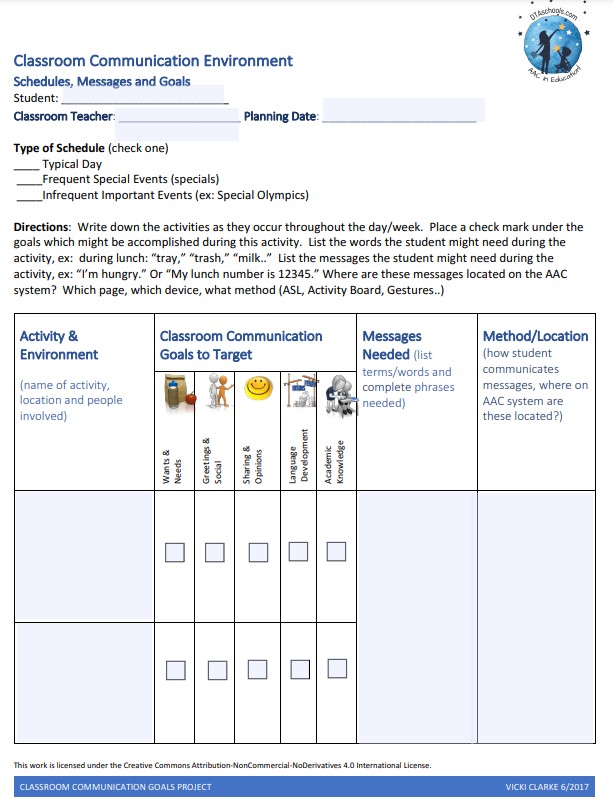
Home & Community Communication Schedule Analysis:
Just like the Classroom Schedule Analysis, this form helps you think about all of the opportunities students have to communicate at home and around town. Start by writing down each activity during the day in the first column. Then go to the Messages column and think about what your student needs to be able to say during that activity; for example, during breakfast, they may need to be able to say the names of foods and make comments like
“yummy!” or “gross!!” Once you’ve gone through the whole day, go back and think about where you will put those words and messages.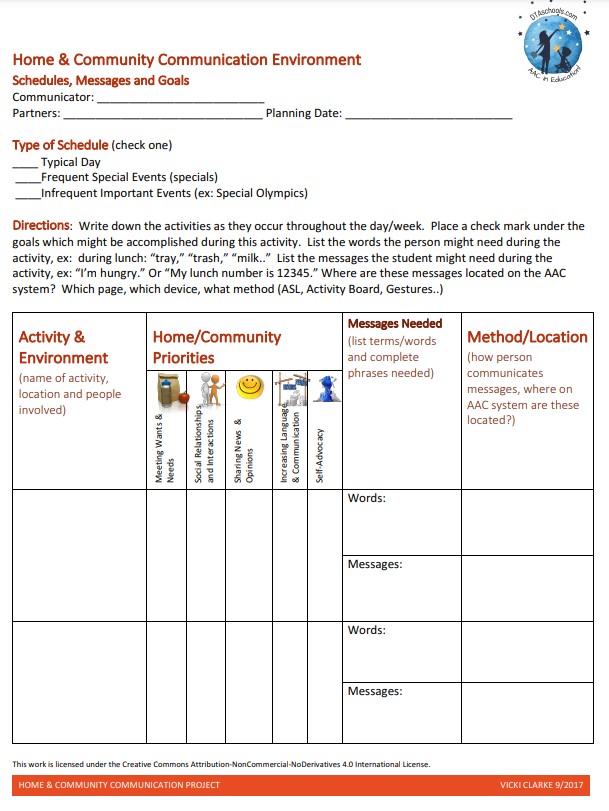
A word of warning! The schedule analysis document can be overwhelming as partners begin to understand just how MANY messages their student needs. It’s important to prioritize the times of day when you will begin to model and introduce these words and messages. To make sure no one gets stuck in “analysis paralysis” be sure to select a manageable, important starting point!
We use a simple technique to prioritize:
- Start at the top of the schedule and ask the team, “which is the most important time to begin to communicate better, activity 1 or activity 2?” If the answer is “activity 1,” move on to the third activity.
- Ask, “Which is most important, activity 1 or activity 3?”
- Continue to compare each activity with the current “most important” one.
- As you work your way through the schedule, you will ultimately identify THE most important time of day to start modeling and communicating! This takes a little time, but when you are finished, the team will have consensus on precisely which daily activities will be addressed first.
The third strategy we used to select appropriate words and messages for our students is considering research and developmental norms. This is primarily important for our students who are learning both how to communicate and developing age-appropriate language skills at the same time. In addition to our standard language and communication assessments, there are a few other options to consider.
In the AAC world, you will hear many people talking about “core word” instruction. Core words are simply very high-frequency words that can be powerful when our AAC users are just beginning to communicate. They can be used across activities and environments in order to communicate functionally. There are approximately 200 to 400 of these words that you can target to make a quick impact on your student’s ability to communicate. These “power words” should be a part of any introduction to AAC, in some capacity. For very emergent communicators, we will start with those highly motivating words and messages, but we still need to provide models and exposure to core words!
Another tool you can use to help determine appropriate words and messages is the Classroom Communication and AAC Goals Grid. You will use this form to assess your student’s current communication skills for five primary objectives:
- communicating wants and needs,
- communicating for social exchanges,
- communicating to share information,
- language development and
- communicating for the purpose of participating in the academic environment.
Finally, you want to consider the developmental norms in the areas of language, including vocabulary and pragmatics, or social messaging. The same developmental norms we consider for our speaking students are also relevant for minimally verbal or nonverbal students.
Let us know how YOU choose words and messages to target for your students using AAC!
Direct Link to Video: https://youtu.be/PT0-c0WeSPs
About the Guest Author
Vicki Clarke is the CEO of Dynamic Therapy Associates, Inc and Director of DTA Schools, a division of DTA Inc, supporting both individual student growth and, system-wide focus on the development of augmentative communication skills, supports, and best practices in special education programs. Additional professional activities include professional consultation and training through publications, workshops, and presentations at local, state, and national conferences in the areas of AAC, speech-language pathology, special education, and Autism.
Filed under: Featured Posts, PrAACtical Thinking
This post was written by Carole Zangari
